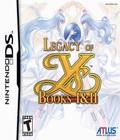Genre: Action Role-Playing
Publisher: Atlus
Developer: Nihon Falcom
Release Date: February 24, 2009
More articles about Legacy of Ys: Books I & II

As an Amazon Associate, we earn commission from qualifying purchases.
 One of the most heralded action RPG franchises of all time, Legacy of Ys: Books I & II delivers the first two epic adventures of the famed saga on one cartridge, presented with a series of never-before-seen enhancements.
One of the most heralded action RPG franchises of all time, Legacy of Ys: Books I & II delivers the first two epic adventures of the famed saga on one cartridge, presented with a series of never-before-seen enhancements.Genre: Action Role-Playing
Publisher: Atlus
Developer: Nihon Falcom
Release Date: February 24, 2009